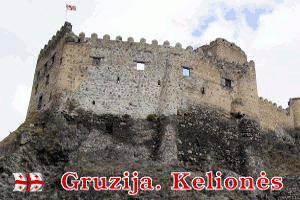The lakes of the Great Lakes Depression and the Mongolian Altai
Most lakes of West Mongolia situated in the Great Lakes Depression. This is a large area (area appprox. 100 000 sq. km.) bounded by the Mongolian Altai in the west, the Gobi Altai in the south, the Khangai mountains in the east and the Tannu-Ula mountains in the north. Small northern parts of the depression are part of Russia. The Great Lakes Depression is a semi-arid depression that covers parts of the Uvs, Khovd, Bayan-Olgii, Zavkhan and Govi-Altai aimags, stretches approx. 600 km from north to south and approx. 160 km from east to west with elevations from 750 to 2000 m. he main types of terrain in the Great Lakes Hollow - rocky mountains, sloping plains, lakes plains, as well as different types of sand bodies. It includes 14 000 sq. km of solonchaks and large sandy areas, northern parts are dominated by arid steppes, and southern by semideserts or deserts. The uniqueness of the depression is many natural areas in relatively small area; on the bottom of the depression are sand and clay deserts; in subalpine plains - the dry steppes; above, on the mountain slopes - high grass steppes transition to forest-steppes; above the cedar-larch forests; at the peaks - mountain tundra. There are the most northerly deserts and the southernmost mountain tundra in the world. The lakes in the Great Lakes Depression salty, bitter-salty and fresh water from the largest lake of Mongolia the lake Uvs-Nuur to small mountain lakes. The lakes are fed by mountain rivers and brooks. Most of the large lakes is endorheic. The depression is a major freshwater basin of Mongolia and contains important wetlands. The wetlands are based on the system of interconnected shallow lakes with wide reed belts within a generally desert steppe. Through the depression area goes bird migration route from Western and Central Siberian. The wetlands support a number of rare and endangered migrating birds: White pelican, White-tailed Eagle, Eurasian Spoonbill, Bar-headed Goose Black Stork, Osprey, White-tailed Eagle, Swan Goose and many other species of birds.
In Western Mongolia lakes, although not so large, you can find also in the Mongolian Altai. Most of them are fresh water.
 |
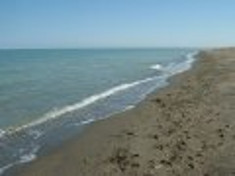 |
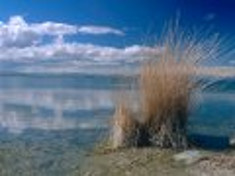 |
| The lake Uvs-Nuur | The lake Uvs-Nuur | The lake Khar-Us-Nuur |
THE LAKE UVS-NUUR. (Mongolian: Увс нуур) The largest lake in Mongolia and the best known of the Great Lakes Depressions lakes. The lake is a highly saline (salt concentration in the water is 18.9 grams per liter - 5 times higher than in the ocean), endorheic, lies at 759 m above sea level. Surface area of the lake is 3350 sq. km., lenght - 84 km, average width - 48 km, maximal width 79 km. The lake feeds by the rivers the Baruunturuun, the Nariin-gol, the Tes from Khangai Mountains in the east, and the Kharkhiraa River and the Sangil-gol from the Mongolian Altai Mountains in the west.The largest settlement near the lake is Ulaangom. The lake districts - unique microclimate, allowing for various natural areas exist. The lake freezes over from October to May. In summer a temperature of the lake is from 25°C at the surface to 19°C at the bottom. The lake is home to a lot of different kinds of birds and 29 different species of fish. All of the lake and many parts of its surroundings have been declared protected sites. The lake shores has been inhabited for at least 2000 years ago - a lot of burial mounds, "deer" stones, petroglyphs and runes left here lived the nomadic tribes - the Huns, the Turks, the Kyrgyz.
THE LAKE KHAR-US-NUUR. (Mongolian: Хар-Ус нуур, lit. "The lake of Black Water"). Second df the largest lake in Mongolia. The lake is the upper one in a system of the interconnected lakes: the Khar-Us, the Khar, the Dorgon, the Airag and the Khyargas. Area of the lake 1852 sq. km, length - 72.2 km, average width - 26 km, maximal width - 27 km, average depth - 2 m, maximal depth - 4.5 m, volume - 3,43 km³., area of basin - 70 450 sq. km, salt concentration in the water is 0,34 grams per liter, surface elevation - 1157 m. Into the lake flows the largest river of the Mongolian Altai the Kobdo-Gol and a few brooks. Outflows the river Chono-Kharaikh-Gol to the lake Dalai-Nuur. The lake is home to a lot of wild birds, fishes - mongoliškas grayling and osman. Near the lake is village Dorgon. In Avgash peninsula is the Paleolithic era Petroglyphs - on the rock Tsakhiuur depicts deer, ibex, rams, and people shooting from the arc. Near the lake is an ancient irrigation channel, built 1400 years ago in Turkic khaganate times, also along the western shore of the Khar-Us-Nuur is so called Genghis Khan's wall runs
THE LAKE KHYARGAS-NUUR. (Mongolian: Хяргас нуур) located in Khyargas district, Uvs Province. Area of the lake 1360 sq. km, length - 80 km, average width - 20 km, maximal width - 31 km, average depth - 47 m, maximal depth - 80 m, volume - 56 km³., area of basin - 115 500 sq. km, salt concentration in the water is 7,23 grams per liter, surface elevation - 1029 m. The lake is salty, endorheic. Into the lake inflows the river Zavkhan from the lake Airag-Nuur.
According to Mongolian legends, at wanderings time from Khakassia Minusinsk Valley to the Tian-Shan mountains in valley of the lake lived Kyrgyz tribes. In lake districts are found a lot of Kyrgyz build 'deer' stones. The lake Khyargas-Nuur actively "wandering". Tectonic shifts during an incomplete decade shifted the lake approx. 20 kilometers to the west.
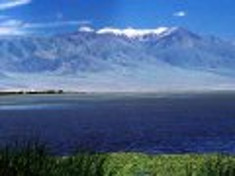 |
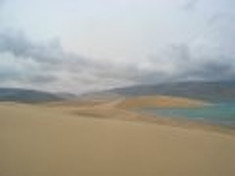 |
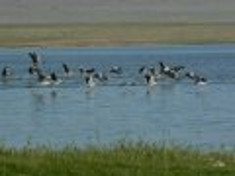 |
| The lake Khar-Us-Nuur | The lake Khar-Nuur | The lake Achit-Nuur |
THE LAKE KHAR-NUUR (Mongolian: Хар нуур, lit. "Black lake"). Area of the lake 575 sq. km, length - 37 km, average width - 16 km, maximal width - 24 km, average depth - 4,6 m, maximal depth - 7 m, volume - 1,42 km³., area of basin - 72 000 sq. km, salt concentration in the water is 0,39 grams per liter, surface elevation - 1132 m. From the lake Dalai-Nuur inflows the river Chono-Kharaikhyn-Gol (The Wolf God River), otflows the river Teeliin Gol to the river Dzabchan-Gol. The lake is part of a group of lakes that were once part of a larger prehistoric lake that disappeared 5,000 years ago as the region became drier.On the right side of the lake lies large Gobi-Altai sands.
THE DORGON-NUUR (Mongolian: Дөргөн нуур). The saltwater lake in Khovd aimag. Area of the lake 305 sq. km, length - 24 km, average width - 13 km, maximal width - 17 km, average depth - 14 m, maximal depth - 27 m, volume - 4,37 km³, salt concentration in the water is 4,00 grams per liter, surface elevation - 1132 m. Conects with the Lake Khar-Nuur by Khomyn Canal.
THE LAKE ACHIT-NUUR (Mongolian: Ачит Нуур). The largest freshwater lake in Mongolia. The lake located near Russian - Mongolian border. The shores is covered with steppes, mostly hilly but swampy on the northwest and northeast. Area of the lake 290 sq. km, length - 24 km, average width - 12 km, maximal width - 18 km, average depth - 2 m, maximal depth - 5 m, volume - 0.67 km³., area of basin - 10 500 sq. km, salt concentration in the water is 0.18 grams per liter, surface elevation - 1435 m. Into the lake inflows the rivers the Dzakhyn-Us-Gol, the Baga-Khatugiin-Gol, Bukh-Muren-Gol, Altan-Gadasny-Chev, otflows the river to the Kobdo-Gol river.
THE LAKE UUREG-NUUR.(Mongolian: Үүрэг нуур) is saltwater highlands lake in very clear water at Mongolian - Russian border. Area of the lake 238 sq. km, length - 20 km, average width - 12 km, maximal width - 18 km, average depth - 15 m, maximal depth - 42 m, volume - 6,42 km³, area of basin - 3360 sq. km, salt concentration in the water is 3,96 grams per liter, surface elevation - 1425 m. The lake is endorheic, inflows the river Kargy (Kharagiin-Gol) from the Tuva mountains and several brooks. The valley of the lake, according to many extant Turkic stone statues, burial mounds, drawings on the rocks, was inhabited nomadic tribes for millennia.
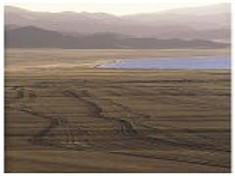 |
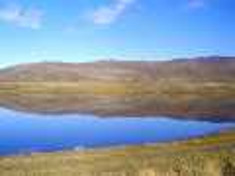 |
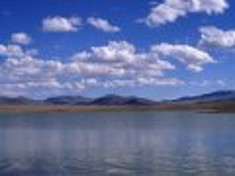 |
| The lake Uureg-Nuur | The lake Airag-Nuur | The lake Tolbo-Nuur |
THE LAKE AIRAG-NUUR (Mongolian: Айраг нуур. The freshwater lake in a system of the interconnected lakes: the Khar-Us, the Khar, the Dorgon and the Khyargas. In summer, the lake warms up almost to the bottom. Area of the lake 143 sq. km, length - 16 km, average width - 9 km, maximal width - 13 km, average depth - 6 m, maximal depth - 10 m, volume - 0,82 km³, area of basin - 115 500 sq. km, salt concentration in the water is 1,24 grams per liter, surface elevation - 1030 m. Into the lake inflows the rivers the Dzabkhan-Gol and the Tsagan-Ergiin-Gol, outflows the river to the Khyargas Lake. Compared to other lakes, the water is not very clear.
THE LAKE TOLBO-NUUR. The freshwater lake at the road Khovd - Bayan-Olgii in the Mongolian Altai, Bayan-Olgii aimag. Area of the lake 84 sq. km, length - 21 km, average width - 4 km, maximal width - 7 km, average depth - 7 m, maximal depth - 12,7 m, volume - 0,57 km³, area of basin - 1980 sq. km, salt concentration in the water is 1,24 grams per liter, surface elevation - 2080 m. Into the lake inflows the river Tolbo-Gol and some brooks, otflows the brook to the river Mandakh-Gol. Kažkada ateiviai-Kazakhs considered this lake as sacred.
 |
 |
 |
| The lake Khurgan Nuur | The lake Khurgan Nuur | The lake Khurgan Nuur |
THE LAKE KHORGON-NUUR (Khurgan-Nuur). The freshwater lake in the Mongolian Altai, Altai Tavan Bogd National Park, Bayan-Olgii aimag. Area of the lake 71,1 sq. km, length - 22 km, average width - 3 km, maximal width - 6 km, average depth - 8 m, maximal depth - 28 m, volume - 0,54 km³, area of basin - 3780 sq. km, salt concentration in the water is 0,08 grams per liter, surface elevation - 2072 m. Into the lake inflows the duct from the Khoton-Nuur lake, the rivers the Ikh-Turgenii-Nuur, the Sumdairagiin-Gol, the Utegtiin-Gol and some brooks, outflows the river Kobdo-Gol. The lake is rich in grayling and osmans.
THE LAKE DAYAN-NUUR The freshwater lake in the Mongolian Altai, Altai Tavan Bogd National Park, Bayan-Olgii aimag. Area of the lake 67,2 sq. km, length - 18 km, average width - 4 km, maximal width - 9 km, average depth - 2,5 m, maximal depth - 4,5 m, volume - 1,57 km³, area of basin - 870 sq. km, salt concentration in the water is 0,29 grams per liter, surface elevation - 2232 m. Into the lake inflows the several small rivers, otflows the river Godon-Gol. The lake is rich in grayling and osmans.
THE LAKE KHOTON-NUUR. The freshwater lake in the Mongolian Altai, Altai Tavan Bogd National Park, Bayan-Olgii aimag. Area of the lake 50,1 sq. km, length - 21,5 km, average width - 2,3 km, maximal width - 4 km, average depth - 26 m, maximal depth - 58 m, volume - 1,34 km³, area of basin - 3450 sq. km, salt concentration in the water is 0,09 grams per liter, surface elevation - 2083 m. Into the lake inflows the rivers the Dzagast-Gol, the Khara-Salagiin-Gol, the Tsagan-Us, the Ut-Khaitun-Gol and several brooks, otflows the duct to the lake Khurgan-Nuur. The lake is rich in grayling and Altai osmans.
 |
 |
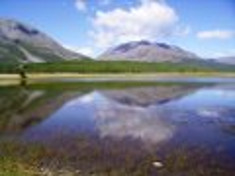 |
| The lake Khurgan Nuur | The lake Dayan-Nuur | The lake Khoton-Nuur |
© J.D.Endriukaitis




